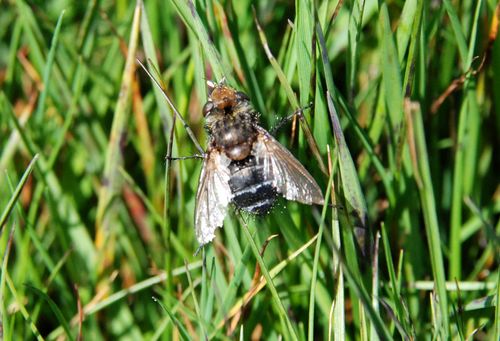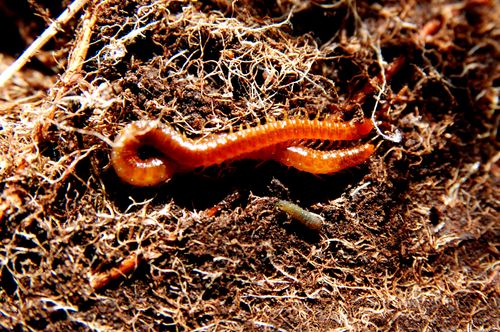Gonia picea (Robineau-Desvoidy, 1830) (Diptera, Tachinidae) and other significant invertebrates from the Malvern Hills (VC37 SO74)
P.F. Whitehead
Moor Leys, Little Comberton, Pershore, Worcestershire, WR10 3EH. Email: paul@thewhiteheads.eu
Introduction
The historical development of the entomofauna of the Malvern Hills is imperfectly understood but there seems little doubt that, when further data has been assembled, its terrestrial fauna will rank amongst the more significant in Britain. The hills are known not only for their distinguished relict species (Whitehead 1989, 1996, 2007, 2010), but also for their ability to collect and assemble convected and windblown insects. This is a well-known phenomenon in mountainous regions but is especially noted at particular times on the Malvern Hills (Whitehead, 1994) which on the east side rise abruptly to mountain altitude above the Jurassic plain. This note documents selected observations made on 3rd May 2014 in full sun in rather cool windy conditions, when the ladybirds Harmonia axyridis (Pallas, 1773) and Coccinella septempunctata (L.) and the coprophilous scarab beetle Onthophagus similis (Scriba, 1790) were observed on the summit of North Hill. Six species of elaterid beetle were encountered without particular searching and a few Painted Lady and Red Admiral butterflies were moving north (03) along the high crests. The former were notable sun-bleached indicating an origin well to the south.
Selected observations 3 May 2014
Liogluta microptera Thomson, 1867 (Coleoptera, Staphylinidae).
This genus of staphylinid beetles is what may be termed ‘difficult’ due to intraspecific variation which extends also to the genitalia. Old records should be interpreted with care and I am grateful to Marc Tronquet for discussing various aspects of this genus. A female L. microptera from around the Happy Valley spring (264 m O.D.) would seem to be the only acceptable Worcestershire record to date.
Gonia picea (Robineau-Desvoidy, 1830) (Diptera, Tachinidae)
A single worn example of this scarce tachinid fly was observed at the summit of North Hill (398 m O.D.) for about an hour, typically flying short distances before resettling in grass (01). Various muscid flies were observed in full exposure at the same location. Pollen on the fly suggests that it had been visiting nearby flowers of Bilberry Vaccinium myrtillus L. Gonia picea is predominantly a parasitoid of noctuid moths and a previous Worcestershire record was provided by Bingham (2012). In this case however the montane habitat would seem to be unique in Britain although Belshaw (1993) makes reference to the attraction of hilltops for some male tachinids.
Geophilus easoni Arthur, Foddai, Kettle, Lewis, Luczynski, & Minelli, 2001. North Hill, Malvern Hills, 3 May 2014
An example of this species, probably a male (02), was observed on North Hill (397 m O.D.). Until recently this terrestrial species was confused with Geophilus carpophagus Leach, 1814, a quite different arboreal species which also occurs on the Malvern Hills. Geophilus easoni is likely to be under-recorded in Worcestershire from where there appear to be no published records.
Pictures: extended captions
01. Worn Gonia picea (Robineau-Desvoidy, 1830), North Hill, Malvern, 3 May 2014. © P.F. Whitehead.
02. Geophilus easoni Arthur, Foddai, Kettle, Lewis, Luczynski, & Minelli, 2001. North Hill, Malvern Hills, 3 May 2014. © P.F. Whitehead.
03. A rather faded probably far-travelled Vanessa atalanta (L., 1758) (Lepidoptera, Nymphalidae) resting at Worcestershire Beacon, Malvern Hills (398 m O.D.), 3 May 2014. © P.F. Whitehead.
Discussion
The time-honoured entomofauna of the Malvern Hills includes many species which are negatively anthrophilic; a fauna of ‘wild places’. With the increasing development of human settlements negatively and positively anthrophilic faunas will become, and are becoming, increasingly polarised in many parts of Britain and Europe. The Malvern Hills entomofauna include many such ‘wild’ species that shun human activity. Notable amongst these is Onthophagus similis for which the Malvern Hills form a regional population focus. This group of dung beetles declined rapidly following broad climatic deteriorations of the past few thousand years and again more recently in the light of changing animal husbandry practices.
All of this will pose something of an increasing challenge in terms of land management and human access; recent developments regarding pastoralism will undoubtedly have brought benefits to the more ancient elements of the upland entomofauna.
References
Arthur, W., Foddai, D., Kettle, C., Lewis, J. G. E., Luczynski, M. & Minelli, A. 2001. Analysis of segment number and enzyme variation in a centipede reveals a cryptic species Geophilus easoni sp. nov. and raises questions about speciation. Biological Journal of the Linnaean Society 74:489-499.
Belshaw, R., 1993. Tachinid flies. Handbooks for the identification of British insects 10:4a(i). Royal Entomological Society of London.
Bingham, J., 2012. Gonia picea (Robineau-Desvoidy, 1830) Tachinidae, Diptera and Melanimon tibialis (Fabricius, 1781) Tenebrioninae, Coleoptera, Recorded on the Devil's Spittleful Nature Reserve 2012. Worcestershire Record 32:14.
Whitehead, P.F., 1989. An inland record of Calathus mollis (Msh.) from Worcestershire. Entomologist's Monthly Magazine 125:198. [Note: in reality this refers to Calathus cinctus Motschulsky which was not formally recognised as British until after this paper was published].
Whitehead, P.F., 1994. The role of meteorology in an unusually mixed assemblage of Coleoptera. Entomologist's Monthly Magazine 130:200.
Whitehead, P.F., 1996. A modern British record of Aleochara maculata Brisout 1863 (Coleoptera, Staphylinidae) with reference to its ecology. Entomologist's Gazette 47:253-254.
Whitehead, P.F., 2007. New autecological data for Enoicyla pusilla (Burmesiter, 1839) (Trichoptera:Limnephilidae) from the Worcestershire Malvern Hills. Entomologist's Gazette 58:26-28.
Whitehead, P.F., 2010. An overlooked Worcestershire insect, the Snow Flea. Worcestershire Record 28:15.
Images
01. Worn Gonia picea Malvern, 3 May 2014. P.F. Whitehead
02. Geophilus easoni, Malvern Hills, 3 May 2014. P.F. Whitehead.
03. Vanessa atalanta Worcestershire Beacon. P.F. Whitehead

